Practice with the help of enVision Math Common Core Grade 1 Answer Key Topic 2 Fluently Add and Subtract Within 10 regularly and improve your accuracy in solving questions.
enVision Math Common Core 1st Grade Answers Key Topic 2 Fluently Add and Subtract Within 10

enVision STEM Project: Protect Yourself
Find Out Think of things that help Journal: Make a Book Show what plants and animals survive.
What helps human survive?
Do we make things to help protect us?
Journal: Make a Book Show what you found out. In your book, also:
- Make a list of some things that humans make to protect themselves.
- Make up and solve addition and subtraction problems about these things.
Review What You Know
Question 1.
Circle the numbers that are the parts.

Answer:

Explanation:
Given a addition expression
3 + 5 = 8
Here 3 and 5 are the parts that add to make the sum 8.
Question 2.
Circle the numbers that is the whole.

Answer:

Explanation:
Given an addition expression
3 + 5 = 8
Here 3 and 5 are addends and called as parts
The sum 8 is called as whole.
The whole is marked with a circle.
Question 3.
Circle the symbol for equals.
+ – =
Answer:
= is the symbol for equal.
+ is the symbol for addition. It is used to add two numbers.
– is the symbol for subtraction. It is used to find the difference between two numbers.
Understanding Addition
Question 4.
Write an addition equation to match the picture.

Answer:

Explanation:
Number of basket balls = 2
Number of foot balls = 4
Adding these two parts gives the addition expression =
2 + 4 = 6.
Adding the two parts gives the whole = 6.
Question 5.
Bob sees 5 bees. Ella sees some bees. one way to make 8. They see 9 bees in all. How many bees did Ella see? Write an addition equation to solve.
___ + ____ = ____
Answer:

Making Numbers
Question 6.
Draw counters to show one way to make 8.

Answer:

Explanation:
Number of orange circle counters = 4
Number of triangle counters = 4
Adding these two counters makes the whole 8.
4 + 4 = 8.
Other equations to make 8 are
0 + 8 = 8
1 + 7 = 8
2 + 6 = 8
3 + 5 = 8
4 + 4 = 8
5 + 3 = 8
6 + 2 = 8
7 + 1 = 8
8 + 0 = 8
I choose 4 + 4 = 8 equation.
Pick a Project
Project 2A
Where would you like to fly?
Project: Create an Airplane Skit

Answer:

Project 2B
When does lightning flash?
Project: Make a Weather Calendar

Answer:
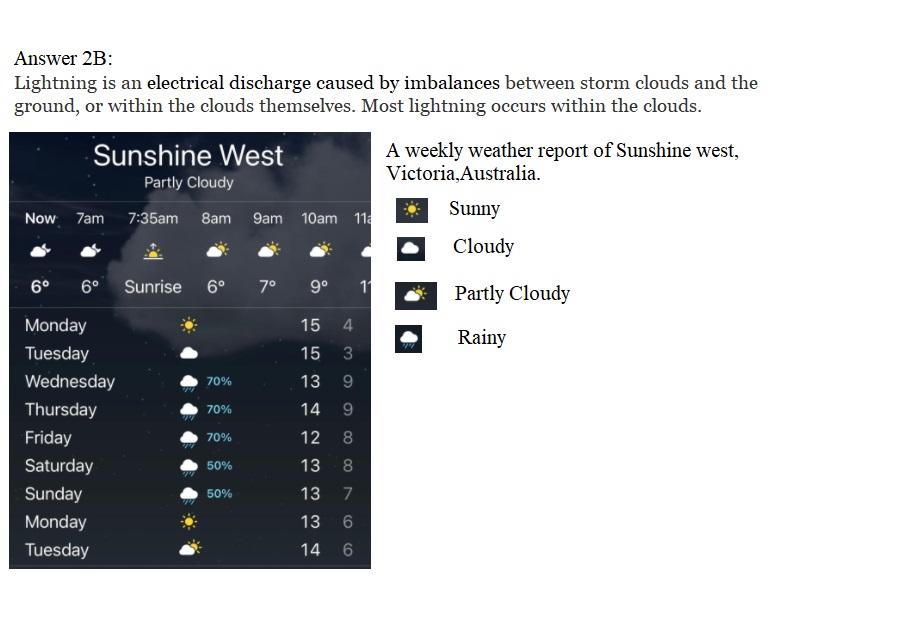
Project 2C
Would you like to travel in space?
Project: Draw a Space Travel Picture

Answer:
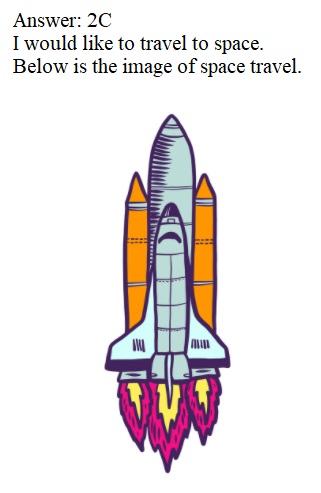
Project 2D
Are these apes or monkeys?
Project: Make a Poster of Apes and Monkeys
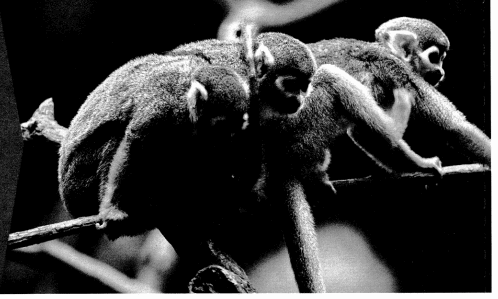
Answer:
These are Monkeys not Apes.

Lesson 2.1 Count On to Add
Solve & Share
You give the rabbit a number card. The rabbit puts that many carrots in the pot. Then he puts 2 more carrots in the pot. How can you find how many carrots are in the pot without counting all the carrots?

Visual Learning Bridge

Convince Me!
How do you add 1 to any number? How do you add 2 to any number?
Guided Practice
Count on to find the sum.
Question 1.

Answer:
3 + 2 = 5
Explanation:
Given
Number on the bucket = 3
Number of carrots = 2
adding these two to find the sum
Addition equation = 3 + 2 = 5.
Sum = 5.
Question 2.

Answer:
8 + 2 = 10
Explanation:
Given
Number on the bucket = 8
Number of apples = 2
Adding these two parts to find the sum
Addition equation =
8 + 2 = 10.
Sum = 10.
Question 3.

Answer:
3 + 3 = 6
Explanation:
Given
Number on the bucket = 3
Number of Tomatoes = 3
Adding these two parts to find the sum
Addition equation =
3 + 3 = 6.
Sum = 6.
Question 4.

Answer:
7 + 2 = 9
Explanation:
Given
Number on the bucket = 7
Number of Bell peppers = 2
Adding these two parts to find the sum
Addition equation =
7 + 2 = 9.
Sum = 9.
Independent Practice
Count on to add.

Question 5.
2 + 3 = ____
Answer:
2 + 3 = 5

Explanation:
using number line to solve the addition equation.
2 + 3 = 5
3 is added to 2 to make it 5
we add +1 three times to 2.
starting number is 2
from 2 we add +1
2 + 1 = 3
from 3 we add +1
3 + 1 = 4
from 4 we add +1
4 + 1 = 5.
after adding +1 three times to 2 we get the sum 5
2 + 1 + 1 + 1 = 5.
2 + 3 = 5.
Question 6.
8 + 1 = _____
Answer:
8 + 1 = 9

Explanation:
using number line to solve the addition equation.
8 + 1 = 9
1 is added to 8 to make it 9
we add +1 to 8.
starting number is 8
from 8 we add +1
8 + 1 = 9.
Question 7.
7 + 1 = ____
Answer:

Explanation:
using number line to solve the addition equation.
7 + 1 = 8
1 is added to 7 to make it 8
we add +1 to 7.
starting number is 7.
from 7 we add +1
7 + 1 = 8.
Question 8.
9 + 1 = ____
Answer:

Explanation:
using number line to solve the addition equation.
9 + 1 = 10
1 is added to 9 to make it 10
we add +1 to 9.
starting number is 9.
from 9 we add +1
9 + 1 = 10.
Question 9.
4 + 3 = ____
Answer:
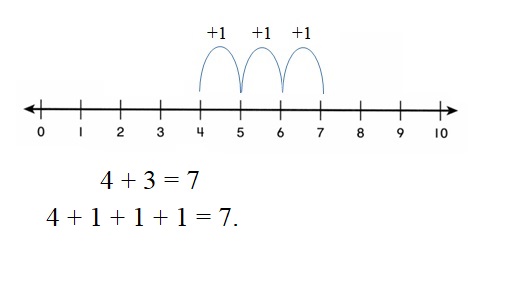
Explanation:
using number line to solve the addition equation.
4 + 3 = 7
3 is added to 4 to make it 7
we add +1 three times to 4.
starting number is 4
from 4 we add +1
4 + 1 = 5
from 5 we add +1
5 + 1 = 6
from 6 we add +1
6 + 1 = 7.
after adding +1 three times to 4 we get the sum 7
4 + 1 + 1 + 1 = 7.
4 + 3 = 7.
Question 10.
9 = 6+ ___
Answer:

Explanation:
using number line to solve the equation.
9 = 6 +
to get sum 9 from 6 we add 3 to 6.
3 is added to 6 to make it 9
we add +1 three times to 6.
starting number is 6
from 6 we add +1
6 + 1 = 7
from 7 we add +1
7 + 1 = 8
from 8 we add +1
8 + 1 = 9.
after adding +1 three times to 6 we get the required sum 9
6 + 1 + 1 + 1 = 6 + 3 = 9.
9 = 6 + 3.
Question 11.
2 + 6 = ___
Answer:

Explanation:
using number line to solve the addition equation.
2 + 6 = 8
6 is added to 2 to make it 8
we add +1 six times to 2.
starting number is 2
from 2 we add +1
2 + 1 = 3
from 3 we add +1
3 + 1 = 4
from 4 we add +1
4 + 1 = 5.
from 5 we add +1
5 + 1 = 6
from 6 we add +1
6 + 1 = 7
from 7 we add +1
7 + 1 = 8.
after adding +1 six times to 2 we get the sum 8
2 + 1 + 1 + 1 + 1 +1 +1 = 8.
2 + 6 = 8.
Question 12.
6 = 5 + ___
Answer:

Explanation:
using number line to solve the equation.
6 = 5 +
6 – 5 = 1
to get sum 6 from 5 we add 1 to 6.
1 is added to 5 to make it 6
we add +1 to 5.
starting number is 5
from 5 we add +1
5 + 1 = 6
6 = 5 + 1.
Question 13.
5 + 3 = ___
Answer:

Explanation:
using number line to solve the addition equation.
5 + 3 = 8
3 is added to 5 to make it 8
we add +1 three times to 5.
starting number is 5
from 5 we add +1
5 + 1 = 6
from 6 we add +1
6 + 1 = 7
from 7 we add +1
7 + 1 = 8.
after adding +1 three times to 5 we get the sum 8
5 + 1 + 1 + 1 = 8.
5 + 3 = 8.
Question 14.
Number Sense
Circle True or False. Count on to help you.

Answer:

Problem Solving
Draw a picture and write an equation to help solve each problem.
Question 15.
Model
Dana has 7 grapes.
She gets 3 more.
How many grapes now?

Answer:
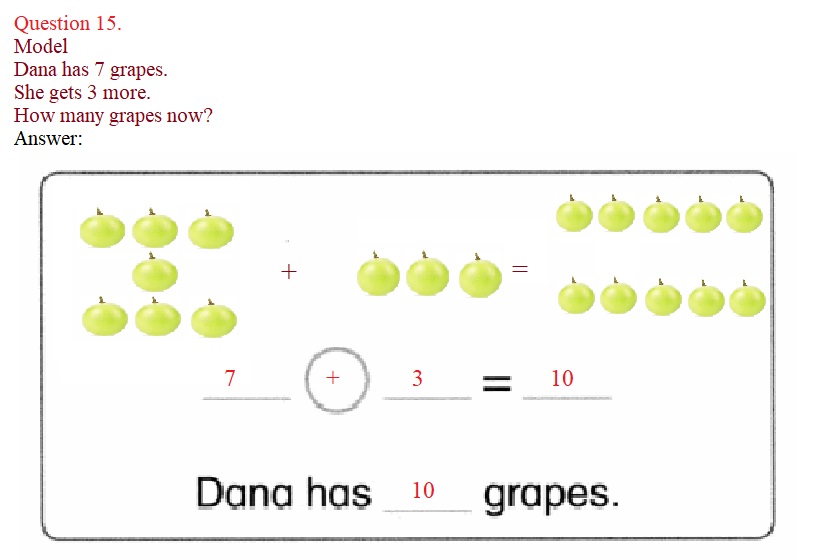
Explanation:
Number of grapes Dana has = 7
Number of grapes she gets = 3
Total number of grapes Dana has now = 7 + 3 = 10.
Question 16.
Model
Anna fills 6 bowls. Jason fills some more. Now there are 9 bowls filled. How many bowls did Jason fill?

Answer:

Question 17.
Higher Order Thinking
Max has 1 more carrot than Jena. Jena has 3 more carrots than Sal. Sal has 4 carrots.
Write how many carrots each person has.

Answer:

Question 18.
Assessment Practice
Which is the sum for 5 + 2?
A. 3
B. 6
C. 7
D. 8

Answer:

Lesson 2.2 Doubles
Solve & Share
Emily and I have the same number of toys. How many toys could each of us have? How many toys do we have in all? You can use cubes to help.

Visual Learning Bridge

Answer:
Convince Me!
Is 6 + 4 a double? Explain.
Answer:
No, 6 + 4 is not a double.
because the first addend is 6 and the second addend is 4 their is difference of 2 in between the two addends
6 – 4 = 2.
6 + 6 is a double
4 + 4 is double for the given equation.
Guided Practice
Write the sum for each double.
Question 1.
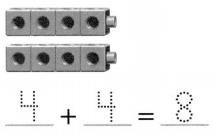
Answer:
4 + 4 = 8
Explanation:
Given a cube stick
The first cube stick have 4 cubes and the second cube stick has 4 cubes .
Both the cubes have same number of cubes and each cube have a pair so they form doubles.
On Adding these doubles
4 + 4 = 8
gives the sum 8.
Question 2.

Answer:
5 + 5 = 10
Explanation:
Given a cube stick
The first cube stick have 5 cubes and the second cube stick has 5 cubes .
Both the cubes have same number of cubes and each cube have a pair so they form doubles.
On Adding these doubles
5 + 5 = 10
gives the sum 10.
Question 3.

Answer:
3 + 3 = 6
Explanation:
Given a cube stick
The first cube stick have 3 cubes and the second cube stick has 3 cubes .
Both the cubes have same number of cubes and each cube have a pair so they form doubles.
On Adding these doubles
3 + 3 = 6
gives the sum 6.
Question 4.

Answer:
2 + 2 = 4
Explanation:
Given a cube stick
The first cube stick have 2 cubes and the second cube stick has 2 cubes .
Both the cubes have same number of cubes and each cube have a pair so they form doubles.
On Adding these doubles
2 + 2 = 4
gives the sum 4.
Independent Practice
Write the sum for each doubles fact.
Question 5.

Answer:
5 + 5 = 10
Explanation:
Given a cube stick
The first cube stick have 5 cubes and the second cube stick has 5 cubes .
Both the cubes have same number of cubes and each cube have a pair so they form doubles.
On Adding these doubles
5 + 5 = 10
gives the sum 10
Question 6.

Answer:
1 + 1 = 2
Explanation:
Given a cube stick
The first cube stick have 1 cubes and the second cube stick has 1 cubes .
Both the cubes have same number of cubes and each cube have a pair so they form doubles.
On Adding these doubles
1 + 1 = 2
gives the sum 2.
Question 7.

Answer:
3 + 3 = 6
Explanation:
Given a cube stick
The first cube stick have 3 cubes and the second cube stick has 3 cubes .
Both the cubes have same number of cubes and each cube have a pair so they form doubles.
On Adding these doubles
3 + 3 = 6
gives the sum 6.
Question 8.

Answer:

Question 9.

Answer:

Question 10.

Answer:

Explanation:
Adding zeros gives the sum 0.
Adding any number to 0 gives the sum the number itself.
Question 11.
Vocabulary
Draw a picture to show a doubles fact. Then write the addition equation to match.

Answer:

Problem Solving
Draw a picture and solve each problem.
Question 12.
Make Sense
Neela makes 4 pies. John makes the same number of pies. How many pies do they make in all?

__ pies
Answer:

Question 13.
Make Sense
Kim has 2 pockets. She has 5 dimes in each pocket. How many dimes does Kim have in all?
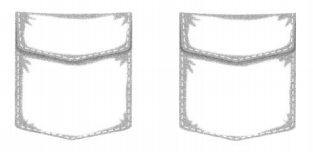
__ dimes
Answer:

Question 14.
Higher Order Thinking
Can a doubles fact have a sum of 9? Draw a picture to find out. Circle Yes or No.

Answer:

Question 15.
Assessment Practice
Which doubles fact has a sum of 6?
A. 2 + 2
B. 3 + 2
C. 3 + 3
D. 4 + 4
Answer:
2 + 2 = 4
3 + 2 = 5
3 + 3 = 6
4 + 4 = 8
2 + 2, 3 + 3, 4 + 4 are all the doubles. 3+2 is not a double.
3 + 3 double fact have the sum 6.
C is the answer.
Lesson 2.3 Near Doubles
Solve & Share
Look at these addition problems.
3 + 3 2 + 2 4 + 5 3 + 4 2 + 3 4 + 4
How are they alike? How are they different? Sort them into two groups and write them in the buckets.


Visual Learning Bridge

Convince Me!
How does knowing 3 + 3 help you find 3 + 4?
Answer:
sum of 3 + 4 = 7 to solve this
3 + 3 = 6
6 + 1 gives the sum 7.
double 3 + 3 plus 1 more gives the sum of 3 + 4.
Guided Practice
Use a doubles fact to find each Practice near doubles fact.
Question 1.
2 + 3 = ?

Answer:

Explanation:
To find the answer using doubles we take two addends and double the smaller addend
2 and 3 are the addends
2 is less than 3. So,we take 2 and double it
2 + 2 = 4
2 + 3 = 5
5 is 4 plus 1 more
Question 2.
2 + 4 = ?
___ + __ = ___
So, __ + __ = ___.
Answer:
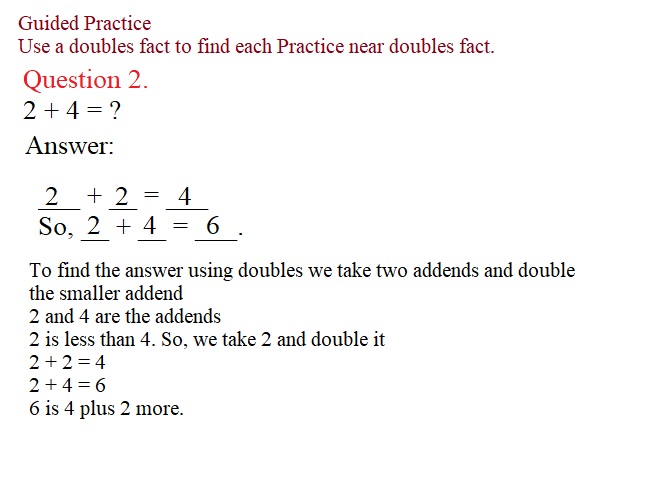
Explanation:
To find the answer using doubles we take two addends and double the smaller addend
2 and 4 are the addends
2 is less than 4. So,we take 2 and double it
2 + 2 = 4
2 + 4 = 6
6 is 4 plus 2 more.
Lesson 2.3 Near Doubles
Solve & Share
Look at these addition problems.
3 + 3 2 + 2 4 + 5 3 + 4 2 + 3 4 + 4
How are they alike? How are they different? Sort them into two groups and write them in the buckets.

Independent Practice
Use a doubles fact to find each near doubles fact.
Question 3.
3 + 4 = ?
__ +__ = ____
So, ___+ ___ = ____
Answer:
3 + 3 = 6
So, 3 + 4 = 7
Explanation:
To find the answer using doubles we take two addends and double the smaller addend
3 and 4 are the addends
3 is less than 4. So, we take 3 and double it
3 + 3 = 6
3 + 4 = 7
7 is 6 plus 1 more.
Question 4.
3 + 5 = ?
___ + ___ = ___
So, ___ +___= ____
Answer:
3 + 3 = 6
So, 3 + 5 = 8
Explanation:
To find the answer using doubles we take two addends and double the smaller addend
3 and 5 are the addends
3 is less than 5. So, we take 3 and double it
3 + 3 = 6
3 + 5 = 8
8 is 6 plus 2 more.
Question 5.

Answer:

Explanation:
To find the answer using doubles we take two addends and double the smaller addend
4 and 5 are the addends
4 is less than 5. So, we take 4 and double it
4 +4 = 8
4 + 5 = 9
9 is 8 plus 1 more.
Question 6.

Answer:

Explanation:
To find the answer using doubles we take two addends and double the smaller addend
2 and 4 are the addends
2 is less than 4. So, we take 2 and double it
2 + 2 = 4
2 + 4 = 6
6 is 4 plus 2 more.
Question 7.

Answer:

Explanation:
To find the answer using doubles we take two addends and double the smaller addend
2 and 1 are the addends
1 is less than 2. So, we take 1 and double it
1 + 1 = 2
1 + 2 = 3
3 is 2 plus 1 more.
Question 8.
3 + 2 = ___
Answer:
3 + 2 = 5
2 + 2 = 4
So, 3 + 2 = 5
Explanation:
To find the answer using doubles we take two addends and double the smaller addend
3 and 2 are the addends
2 is less than 3. So, we take 2 and double it
2 + 2 = 4
3 + 2 = 5
5 is 4 plus 1 more.
Question 9.
1 + 3 = ___
Answer:
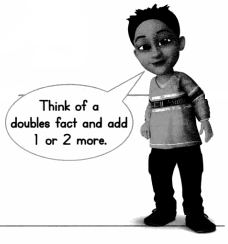
1 + 3 = 4
1 + 1 = 2
So, 1 + 3 = 4
Explanation:
To find the answer using doubles we take two addends and double the smaller addend
1 and 3 are the addends
1 is less than 3. So, we take 1 and double it
1 + 1 = 2
1 + 3 = 4
4 is 2 plus 2 more.
Number Sense
Write the missing numbers.
Question 10.
If 2 + __ = 4, then 2 + ___ = 5.
Answer:
If 2 + _2_ = 4, then 2 + _3__ = 5.
4 – 2 = 2
5 – 2 = 3
Explanation:
To find the answer using doubles we take two addends and double the smaller addend
2 and 3 are the addends
2 is less than 3. So, we take 2 and double it
2 + 2 = 4
2 + 3 = 5
5 is 4 plus 1 more.
Question 11.
If 4 + ___ = 8, then 4+ __ = 9.
Answer:
If 4 + _4__ = 8, then 4+ _5_ = 9.
8 – 4 = 4
9 – 4 = 5.
Explanation:
To find the answer using doubles we take two addends and double the smaller addend
4 and 5 are the addends
4 is less than 5. So, we take 4 and double it
4 + 4 = 8
4 + 5 = 9
9 is 8 plus 1 more.
Problem Solving
Solve each problem.
Question 12.
Reasoning
Omar eats 2 pears. Jane eats 2 pears and then 2 more. How many pears do Omar and Jane eat in all?
___ pears in all
Answer:
Number of pears Omar eats = 2
Number of pears Jane eats = 2
Number of more pears Jane eats = 2
Total number of pears Jane eats = 2 + 2 = 4 pears.
Total number of pears both Omar and Jane eats = 2 + 4 = 6.
Question 13.
Reasoning
Sam finds 3 shells. Jack finds 4 shells. How many shells do they find in all?
___ shells in all
Answer:
Number of shells Sam finds = 3
Number of shells Jack finds = 4
Total number of shells both Sam and Jack find = 3 + 4 = 7.
Question 14.
Higher Order Thinking
Use a near doubles fact. Write a story that uses that fact. You can use pictures, words, and numbers.
Answer:
While having tea. Jack ate 3 biscuits and Sam ate 3 biscuits first and then he took 2 more. how many biscuits did they both have in all?
Answer:
Number of biscuits Jack ate = 3
Number of biscuits Sam ate = 3
Number of more biscuits Sam ate = 2
Total number of biscuits Sam ate = 3 + 2 = 5
Total n umber of biscuits both Jack and Sam ate = 5 + 3 = 8.
Question 15.
Assessment Practice
Add 4 + 3
A. 10
B. 9
C. 8
D. 7

Answer:
D. 7 is the answer.
4 + 3 = 7
3 + 3 = 6
So, 4 + 3 = 7
7 is 6 plus 1 more.
Explanation:
To find the answer using doubles we take two addends and double the smaller addend
4 and 3 are the addends
3 is less than 4. So, we take 3 and double it
3 + 3 = 6
4 + 3 = 7
7 is 6 plus 1 more.
Lesson 2.4 Facts with 5 on a Ten-Frame
Solve & Share
Take a small handful of counters. Toss them onto the page. Place them on the ten-frame. Write an addition equation to match the red and yellow counters. Tell how a ten-frame helps you add.
 3d
3d
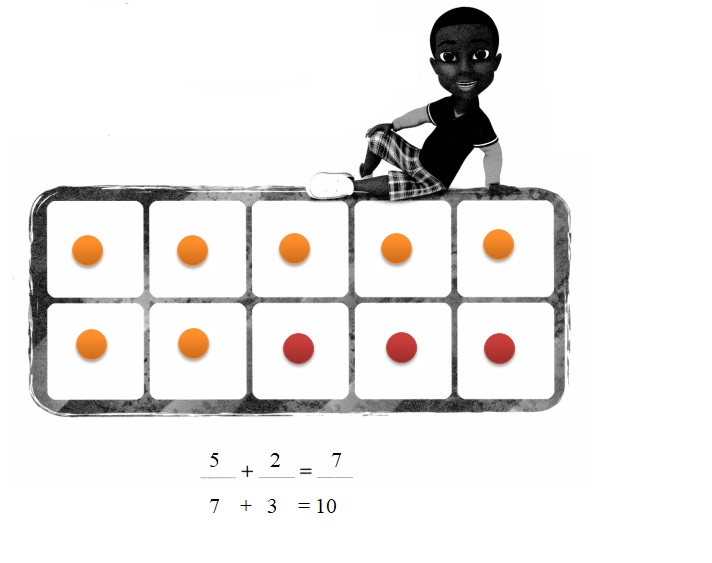
Visual Learning Bridge

Convince Me!
How does a ten-frame help you add 5 + 4?
Guided Practice
Look at the ten-frames. Practice Write an addition fact with 5.
Then write an addition fact for 10.
Question 1.

Answer:
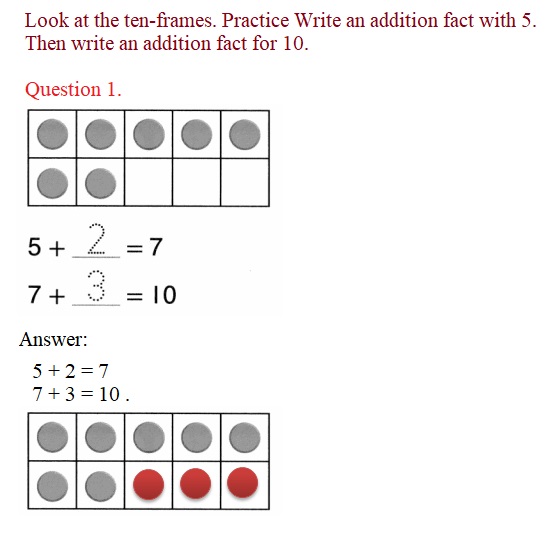
Explanation:
Given a ten frame with 7 counters. Counting the counters with a addition factor of 5.
So, 7 is represented as 5 + 2 = 7.
Now to fill the ten frame we need to add 3 more counters to 7.
7 + 3 = 10.
These 3 counters are represented with red counter.
Question 2.

Answer:

Explanation:
Given a ten frame with 6 counters. Counting the counters with a addition fact with 5.
So, 6 is represented as 5 + 1 = 6.
Now to fill the ten frame we need to add 4 more counters to 6.
6 + 4 = 10.
These 4 counters are represented with red counter.
Independent Practice
Look at the ten-frames. Write an addition fact with 5. Then write an addition fact for 10.
Question 3.

Answer:

Explanation:
Given a ten frame with 6 counters. Counting the counters with a addition fact with 5.
So, 8 is represented as 5 + 3 = 8.
Now to fill the ten frame we need to add 2 more counters to 8.
8 + 2 = 10.
These 2 counters are represented with red counter.
Question 4.
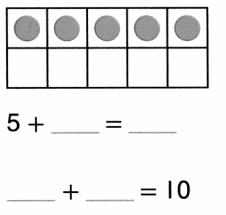
Answer:

Explanation:
Given a ten frame with 6 counters. Counting the counters with a addition fact with 5.
So, 5 is represented as 5 + 0 = 5.
Now to fill the ten frame we need to add 5 more counters to 5.
5 + 5 = 10.
These 5 counters are represented with red counter.
Question 5.

Answer:

Explanation:
Given a ten frame with 6 counters. Counting the counters with a addition fact with 5.
So, 9 is represented as 5 + 4 = 9.
Now to fill the ten frame we need to add 1 more counters to 9.
9 + 1 = 10.
These 1 counters are represented with red counter.
Question 6.
Higher Order Thinking
Use 2 colors to draw counters in the ten-frames. Match the addition equations. Then write the missing numbers.

Answer:

Problem Solving
Solve each problem below.
Question 7.
Model
A team has 5 balls. The coach brings 3 more balls. How many balls does the team have now? You can use the ten-frame to help.

___ balls
Answer:

Question 8.
Model
Kami reads 5 books. Sue reads 4 books. How many books did the girls read in all?
You can use the ten-frame to help.

___ books
Answer:
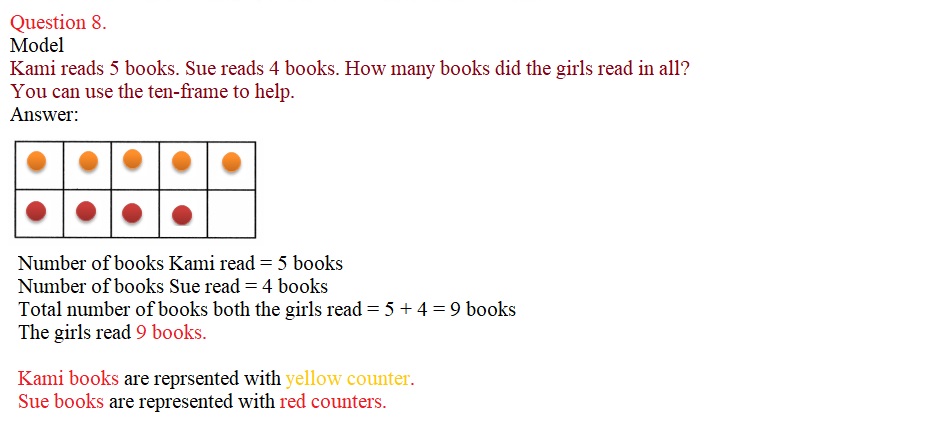
Question 9.
Higher Order Thinking
Write a story with an addition fact for 10. Then write an equation for your story.

Answer:

Question 10.
Assessment Practice
Which sums equal 10? Choose two that apply.

Answer:
5 + 5 = 10
7 + 3 = 10.
These two equations have sum equal to 10.
6 + 3 = 9.
4 + 7 = 11.
Lesson 2.5 Add in Any Order
Write an addition equation for the green and yellow cubes in each cube tower. How are the addition equations the same? How are they different?

Answer:

Visual Learning Bridge

Convince Me!
How can you use cubes to show that 5 + 3 is the same as 3 + 5?
Answer:

Guided Practice
Color to change the order of the addends. Then write the addition equations.
Question 1.

Answer:

Explanation:
Given a 7 cube tower.
An addition equation 3 + 4
3 and 4 are addend that make 7.
Changing the addends we get the same sum of 7.
An addition equation of 4 + 3 = 7
where 3 cubes are red color
4 cubes are blue color.
4 + 3 = 7.
Question 2.

Answer:

Explanation:
Given a 5 cube tower.
To make 5 we have add two addend to make it 5
2 and 3 are one of the addend that make 5.
An addition equation of 2 + 3 = 5
where 2 cubes are Green color
3 cubes are Yellow color.
2 + 3 = 5.
Changing the order of addends gives the same sum 5.
3 + 2 = 5.
3 cubes are Yellow color.
2 cubes are Green color.
Independent Practice
Write the sum. Then change the order of the addends. Write the new addition equation.
Question 3.
2 + 3 = ____
___ + ___ = ___
Answer:
2 + 3 = 5
Changing the order of addends
3 + 2 = 5.
Explanation:
Given an addition equation
2 + 3
Here 2 and 3 are the addends. To find Sum of these two addends we add them
2 + 3 = 5.
sum = 5
On changing the order of these addends we get a new equation
3 + 2
On adding these two addends we get the sum
3 + 2 = 5.
Sum = 5
Even after changing the order of addends we get the same Sum.
Question 4.
1 + 6 = ____
___ + ___ = ___
Answer:
1 + 6 = 7
6 + 1 = 7
Explanation:
Given an addition equation
1 + 6
Here 1 and 6 are the addends. To find Sum of these two addends we add them
1 + 6 = 7
sum = 7
On changing the order of these addends we get a new equation
6 + 1
On adding these two addends we get the sum
6 + 1 = 7
Sum = 7
Even after changing the order of addends we get the same Sum.
Question 5.
____ = 3 + 6
___ + ___ = ___
Answer:
9 = 3 + 6
6 + 3 = 9
Explanation:
Given an addition equation
3 + 6
Here 3 and 6 are the addends. To find Sum of these two addends we add them
3 + 6 = 9
sum = 9
On changing the order of these addends we get a new equation
6 + 3
On adding these two addends we get the sum
6 + 3 = 9
Sum = 9
Even after changing the order of addends we get the same Sum.
Question 6.
5 + 2 = ___
___ + ___ = ___
Answer:
5 + 2 = 7
Changing the order of addends
2 + 5 = 7
Explanation:
Given an addition equation
5 + 2 = 7
Here 5 and 2 are the addends. To find Sum of these two addends we add them
5 + 2 = 7
sum = 7
On changing the order of these addends we get a new equation
2 + 5
On adding these two addends we get the sum
2 + 5 = 7
Sum = 7
Even after changing the order of addends we get the same Sum.
Question 7.
4 + 5 = ___
___ + ___ = ___
Answer:
4 + 5 = 9
Changing the order of addends
5 + 4 = 9
Explanation:
Given an addition equation
4 + 5
Here 4 and 5 are the addends. To find Sum of these two addends we add them
4 + 5 = 9
sum = 9
On changing the order of these addends we get a new equation
5 + 4
On adding these two addends we get the sum
5 + 4 = 9
Sum = 9
Even after changing the order of addends we get the same Sum.
Question 8.
6 + 2 = ___
___ + ___ = ___
Answer:
6 + 2 = 8
Changing the order of addends
2 + 6 = 8
Explanation:
Given an addition equation
6 + 2
Here 2 and 6 are the addends. To find Sum of these two addends we add them
6 + 2 = 8
sum =8
On changing the order of these addends we get a new equation
2 + 6
On adding these two addends we get the sum
2 + 6 = 8
Sum = 8
Even after changing the order of addends we get the same Sum.
Number Sense
Use the numbers on the cards to write two addition equations.
Question 9.

Answer:
3 + 5 = 8
5 + 3 = 8
Explanation:
Given 3 number cards. An addition equation have 2 addends and a sum
the card numbers are 3, 5 , 8
On adding two numbers we get the third number. So, we add the two smaller numbers and get the greater number as sum.
3 + 5 = 8.
5 + 3 = 8.
Question 10.

Answer:
4 + 2 = 6
2 + 4 = 6
Explanation:
Given 3 number cards. An addition equation have 2 addends and a sum
the card numbers are 4, 6, 2
On adding two numbers we get the third number. So, we add the two smaller numbers and get the greater number as sum.
4 + 2 = 6
2 + 4 = 6.
Problem Solving
Solve each problem below.
Question 11.
Model
Liza and Anna collect 6 cans. They collect 4 more cans. How many cans do they collect in all?

Draw a picture. Then write two different addition equations.
Answer:

Question 12.
Higher Order Thinking
Draw a picture of 5 birds. Make some blue. Make the rest red.
Write two addition equations to tell about the picture.
Answer:

Question 13.
Assessment Practice
Look at the two addition equations. Which is the missing addend?

Answer:
Given
9 = ? + 2
and
9 = 2 + ?
Here in both the equations
Sum = 9
one addend is given as 2
To find the second addend. we subtract the sum – first addend
9 – 2 = 7.
So, the answer is B) 7.
The equations are
9 = 7 + 2
9 = 2 + 7.
Lesson 2.6 Count Back to Subtract
Solve & Share
There are 5 people on a bus. It stops and 2 people get off. Show how many people are still on the bus. Then write the number.

Visual Learning Bridge

Answer:

Convince Me!
Write subtraction equations to show counting back by 1, by 2, and by 3.
Answer:

Guided Practice
Count back to complete each Practice subtraction fact.

Answer:
Question 1.

Answer:

Explanation:
Given 2 equation
4 – 1 = 3 and 4 – 0 = 4
In the first equation 1 is subtracted from 4 and leaves the difference 3
whereas in the second equation 0 is subtracted from 4 leaves the difference 4.
when subtracting 0 from any number gives the difference the number itself.
Using number line to represent these equations as shown in the above image.
Question 2.

Answer:

Explanation:
Given 2 equation
6 – 0 = 6 and 6 – 2 = 4
In the first equation 0 is subtracted from 6 and leaves the difference 6
when subtracting 0 from any number gives the difference the number itself.
In the second equation 2 is subtracted from 6 leaves the difference 4.
Using number line to represent these equations as shown in the above image.
Question 3.
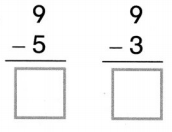
Answer:

Explanation:
Given 2 equation
9 – 5 = 4
9 – 3 = 6
Using number line to represent these equations as shown in the above image
In the first equation 5 is subtracted from 9 and gets the difference 4.
From 9 we count 5 times back and get the answer 4.
In the second equation 3 is subtracted from 9 gets the difference 6.
From 9 we count 3 times back ward and get the answer 6.
Independent Practice
Complete each subtraction fact. + Practice Count back on the number line to help you.

Question 4.

Answer:

Question 5.

Answer:

Question 6.

Answer:

Question 7.

Answer:
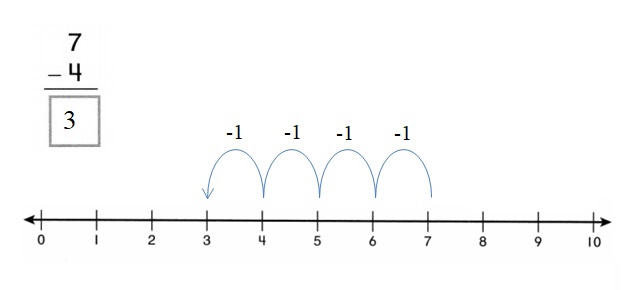
Question 8.

Answer:


Question 9.
Higher Order Thinking
Amy and Ryan buy pencils. Amy buys 10 pencils. Ryan buys 8 pencils. How many fewer pencils does Ryan buy?
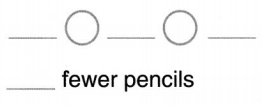
Answer:

Problem Solving
Solve each problem below. Write a subtraction equation to match the problem.
Question 10.
Reasoning
Manny picks a number. His number is 4 less than 8. What is Manny’s number?
___ – ___ = ___
Manny’s number is ___.
Answer:

Question 11.
Reasoning
Beth is thinking of a number. Her number is o less than 10. What is Beth’s number?
Beth’s number is ____
Answer:

Question 12.
Higher Order Thinking
Complete the subtraction equation. Then write a story to match the equation.
5 – 1 = ___
Answer:
5 – 1 = 4.
Story
Abby thinking of a number. Her number is 1 less than 5. What is Abby’s number.
Question 13.
Assessment Practice
Select the difference.
10 – 3 = ___
A. 7
B. 5
C. 3
D. 1

Answer:
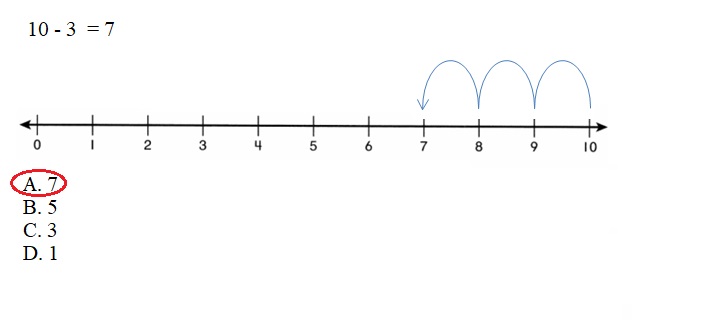
Lesson 2.7 Think Addition to Subtract
Solve & Share
Jenna has 6 balls.
Then 4 balls blow away. How many balls does she have left?
Jenna says she can solve 6-4 by adding to 4. What do you think Jenna did? Show your work.


Visual Learning Bridge

Convince Me!
How can an addition fact help you solve 7 – 6?
Answer:
7 – 6 = ?
6 + 1 = 7
7 – 6 = 1.
Guided Practice
Think addition to help you subtract. Draw the missing part. Then write the missing numbers.
Question 1.

Answer:

Explanation:
Using the tape diagram to solve the problem.
5 – 4 is can also be written as
4 less than 5
5 – 4 = ?
Using addition equation to solve the subtraction equation
4 + 1 = 5
5 – 4 = 1
1 is the missing number.
Question 2.

Answer:

Explanation:
Using the tape diagram to solve the problem.
6 – 5 is can also be written as
5 less than 6
6 – 5 = ?
Using addition equation to solve the subtraction equation
5 + 1 = 6
6 – 5 = 1
1 is the missing number.
Independent Practice
Think addition to help you subtract. Draw the missing part. Then write the missing numbers.
Question 3.
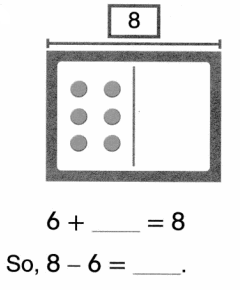
Answer:
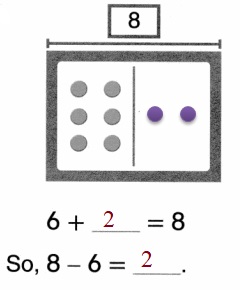
Explanation:
Using the tape diagram to solve the problem.
8 – 6 is can also be written as
6 less than 8
8 – 6 = ?
Using addition equation to solve the subtraction equation
6 + 2 = 8
8 – 6 = 2
2 is the missing number.
Question 4.

Answer:

Explanation:
Using the tape diagram to solve the problem.
7 – 4 is can also be written as
4 less than 7
7 – 4 = ?
Using addition equation to solve the subtraction equation
4 + 3 = 7
7 – 4 = 3
3 is the missing number.
Question 5.

Answer:

Explanation:
Using the tape diagram to solve the problem.
4 – 3 is can also be written as
3 less than 4
4 – 3 = ?
Using addition equation to solve the subtraction equation
3 + 1 = 4
4 – 3 = 1
1 is the missing number.
Question 6.
Higher Order Thinking
Draw the shape to complete the equation.
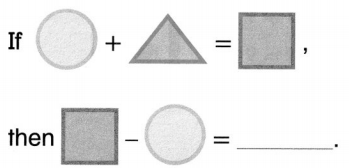

Answer:

Problem Solving
Write an addition equation and a subtraction equation to solve.
Question 7.
Use Tools
Pam needs 8 tickets for a ride. She has 2 tickets.

How many tickets does Pam still need?
__ + __ = ___
___ – __ = ___
___ tickets
Answer:
Total number of tickets Pam need = 8
Number of tickets she have = 2
Number of tickets she need more = 8 – 2
2 + 6 = 8
So, 8 – 2 = 6.
Pam need 6 tickets.
Question 8.
Higher Order Thinking
A box holds 6 crayons. 4 crayons are inside the box. Kathy uses addition to find how many crayons are missing. Is Kathy correct? Explain.

Answer:
Kathy is wrong. She should use subtraction to find the number of crayons missing.
6 – 4 = 2.
2 crayons are missing.
Using addition
6 + 4 = 10 gives us the sum 10.
As the box can only hold 6 crayons. 10 is 4 more than 6.
which is why we use subtraction to find the missing crayons.
Question 9.
Assessment Practice
Which addition facts can help you solve 9 – 2? Choose two that apply.

Answer:

Explanation:
ALL the equation gives the sum 9.
But in the tape diagram there are 2 counters. So, one of the addend is 2.
The equation with one addend 2 are selected.
7 + 2 = 9
2 + 7 = 9.
Lesson 2.8 Solve Word Problems with Facts to 10
Solve & Share
6 fish swim by. Some more fish join them. Now there are 10 fish. How many fish joined the group?

Draw a picture.
Answer:

Visual Learning Bridge

Convince Me!
7 cubes are on a table. Some cubes fall off. Now 3 cubes are on the table. How many cubes fell off the table?
Guided Practice
Draw a picture. Then write an equation and solve.
Question 1.
Maria sees 3 blue birds.

She sees some red birds. Maria sees 9 birds in all. How many red birds did Maria see?
___ red birds

Answer:

Independent Practice
Draw a picture. Then write an equation and solve.
Question 2.
Jamal picks 7 berries. Then Ed picks more berries. They pick 10 berries in all. How many berries did Ed pick?
___ berries
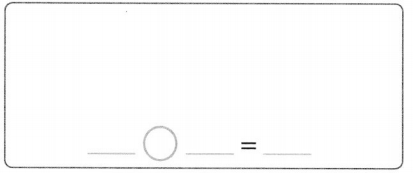
Answer:

Question 3.
Vicky has 8 flowers in her garden. She picks some flowers. Now there are 4 flowers left. How many flowers did Vicky pick?
___ flowers

Answer:

Question 4.
Higher Order Thinking
Write a math story to match the picture. Then write an equation.

Answer:
There are 3 ducks in a pond. Their are some fishes. Now there are 7 animals in the ponds. How many fishes are in the pond?

Problem Solving
Solve each problem. Draw pictures and write equations to help.
Question 5.
Make Sense
Charlie draws 9 stars. Joey draws 4 stars. How many fewer stars did Joey draw than Charlie?
__ fewer stars
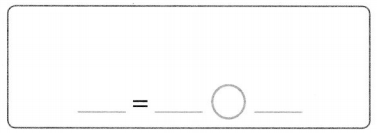
Answer:

Question 6.
Make Sense
Brian finds 3 rocks on Monday. He finds 7 rocks on Friday.
How many more rocks did Brian find on Friday than on Monday?
___ more rocks

Answer:

Question 7.
Higher Order Thinking
Write a math story and an equation to match the picture.

Answer:
There are 6 monkeys playing in the forest. 4 monkey are swinging on the tree and 2 monkeys are sitting on ground. Find how many fewer money are sitting on the ground?

Total number of monkeys = 6
Number of monkeys swinging on the tree = 4
Number of monkeys siting on the ground = 2
Number of fewer monkeys sitting on the ground than swinging on the tree = 4 – 2 = 2.
There are 2 fewer monkeys sitting on the ground than swinging on the tree.
Question 8.
Assessment Practice
5 ducks are in a row. More ducks join them. Now there are 8 ducks. How many ducks joined them?
A. 8 ducks
B. 5 ducks
C. 4 ducks
D. 3 ducks

Answer:

Lesson 2.9 Look For and Use Structure
Solve & Share
Use counters and the part-part whole mat to show different ways to make 10. Write the different ways in the table.
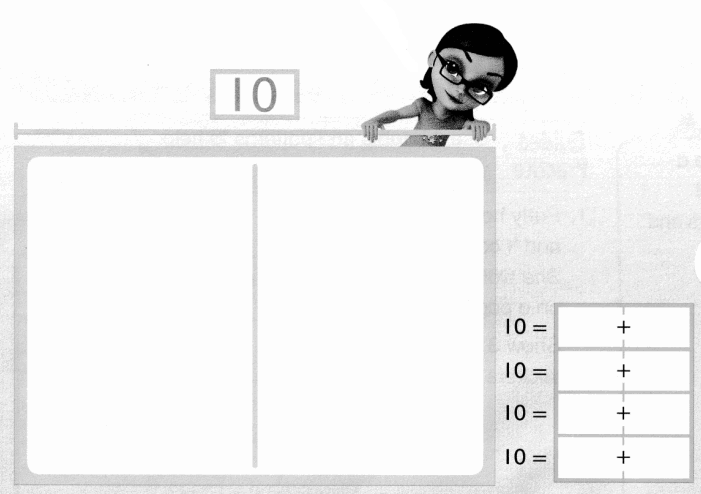
Answer:

Visual Learning Bridge

Convince Me!
Describe a pattern in the table that shows how many bears and lions there are.
Guided Practice
Use the table and patterns to help you solve the problem.
Question 1.
Patty has 4 dog stickers and 4 cat stickers. She wants to put 6 stickers on a page of her book. Show 3 ways Patty can put stickers on the page.

Answer:

Independent Practice
Use patterns to help you solve each problem.
Question 2.
Max has 5 markers. He can put them in his desk or in his bag. Complete the table to show all the ways.

Answer:

Question 3.
Ms. Davis fills a box with 10 prizes. She has 7 balls and 7 balloons. Complete the table to show all the ways.

Answer:


Question 4.
Higher Order Thinking
Julie plants 10 flowers. ___ by a tree and __ in a box
She plants some by a free and some in a box. ___ by a tree and __ in a box
Find 3 ways Julie can plant the flowers. ___ by a tree and __ in a box
Answer:
Julie plants 10 flowers. _4__ by a tree and _6_ in a box
She plants some by a free and some in a box. _5__ by a tree and _5_ in a box
Find 3 ways Julie can plant the flowers. _6__ by a tree and _4_ in a box
Other possible ways are
by a tree + in a box
0 + 10
1 + 9
2 + 8
3 + 7
4 + 6
5 + 5
6 + 4
7 + 3
8 + 2
9 + 1
10 + 0
Problem Solving
Performance Task
Pieces of Fruit
Ed eats 7 pieces of fruit. He eats strawberries and grapes.
Ben and Maria started tables to show all the ways Ed can eat the strawberries and grapes.

Answer:

Question 5.
Model
Complete each table. Use cubes or draw a picture to help you.
Answer:
Question 6.
Look for Patterns
Describe one pattern in each table.
Answer:
In Maria readings
strawberries Grapes
In 1st, 2nd reading increase by 5 decrease by 5
In 2nd and 3rd reading decrease by 3 increase by 3
In 3rd, 4th,5th readings Increase by 1 decrease by 1
In 5th and 6th reading decrease by 3 increase by 3
In 6th , 7 th reading increase by 5 decrease by 5
In 7th and 8th reading decrease by 7 increase by 7
In Ben case
strawberries increase by 1 and grapes decrease by 1
Topic 2 Fluency Practice Activity
Find a partner. Point to a clue. Read the clue. Look below the clues to find a match. Write the clue letter in the box next to the match. Find a match for every clue.

Answer:

Topic 2 Vocabulary Review
Understand Vocabulary
Question 1.
Circle the addition equation that is shown on the number line.

Answer:

Question 2.
Cross out the problems that do NOT show doubles facts.

Answer:

Question 3.
Circle the near doubles facts.

Answer:

Question 4.
Circle the word that completes the sentence. Sam has 6 pens. Bev has 4 pens. Bev has 2 __ pens than Sam.

Answer:
Sam has 6 pens. Bev has 4 pens. Bev has 2 _fewer_ pens than Sam.
Equation
6 – 4 = 2.
Use Vocabulary in Writing
Question 5.
Write and solve a story problem. Use at least one term from the Word List.
Answer:
Set A
8 peppers are in the pot. You can add 1 more by counting I more.

1 more than 8 is 9.

Answer:
1 more than 8 is
8 + 1 = 9
Number of pepper in the pot = 8
Number of more peppers added = 1
Total number of peppers in all = 8 + 1 = 9.
8 plus 1 more makes 9.
Add 0, 1 and 2 to find the sum. Write the addition fact.
Question 1.

Answer:
Number on the tomatoes in the bucket = 9
Number of more tomatoes added = 2
Total number of tomatoes = 9 + 2 = 11.
9 plus 2 more makes 11.
Question 2.
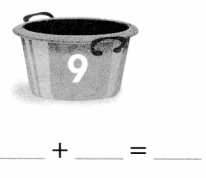
Answer:
Number of balls in the bucket = 9
Number of more balls added = 0
Total number of balls = 9 + 0 = 9
Set B
You can use doubles facts to add.

Both addends are the same. They are doubles.
Answer:
2 + 2 = 4
3 + 3 = 6
Write an addition equation for each doubles fact.
Question 3.

Answer:

Question 4.

How many coins are there in all?
__ + ___= ___
Answer:

Set C
You can use doubles facts to add near doubles.

Find each sum.
Question 5.

Answer:

Set D
You can use a ten-frame to learn facts with 5.
Look at the addition equation. Draw counters in the frame.
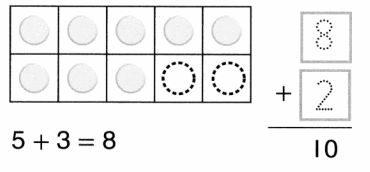
Answer:
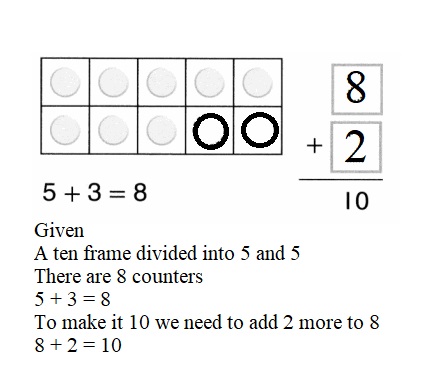
Draw counters and complete the addition problems.
Question 6.

Answer:

Set E
Find the sum.

You can change the order of the addends.
Write the new addition equation.

The sum is the same.
Answer:
2 + 5 = 7
5 + 2 = 7
both the cases the sum is same 7.
Write the sum. Then change the order of the addends and write a new addition equation.
Question 7.
1 + 4 =___
__ + __ = ___
Answer:
1 + 4 = 5
4 + 1 = 5
Sum = 5 in both the cases.
The order of addends is changed.
Question 8.
6 + 3 = ___
__ + __ =___

Answer:
6 + 3 = 9
6 and 3 are the addends and Sum is 9
After changing the order of addends
3 + 6 = 9
We get the same Sum = 9.
Set F
You can subtract by counting back. 2 less than 9 is 7
Write the subtraction fact.

Answer:
Count back to find the difference. Complete each subtraction fact.
Question 9.

1 less than 4 is ____
Answer:

Question 10.
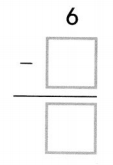
0 less than 6 is ___
Answer:

Set G
You can think addition to help you subtract.

Answer:

Think addition to help you subtract.
Question 11.

4 + __ = __
So, 6 – 4 = ___
Answer:
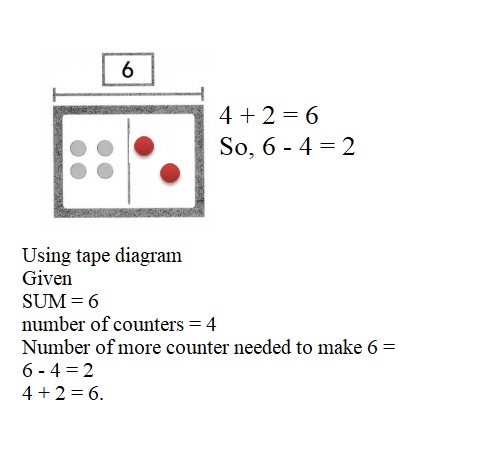
Question 12.

6 + __ = 7
So, 7 – 6 = ___
Answer:

Set H

Dani’s family can care for 3 animals. Dani shows the ways they can care for cats and dogs.
Question 13.
Complete the table below.

Answer:

Question 14.
Describe a pattern you see in the table.
Answer:

Topic 2 Assessment Practice
Question 1.
Molly has 3 toy cars. She gets 4 more as a gift. How many toy cars does Molly have now?
A. 7
B. 8
C. 9
D. 10
Answer:
Number of toy cars Molly has = 3
Number of more cars she gets as a gift = 4
Total number of toy cars Molly have now = 3 + 4 = 7.
Answer is A.
Question 2.
Brad has 5 books. His dad gives him 4 more. How many books does Brad have in all?

A. 1
B. 4
C. 5
D. 9
Answer:
D. 9

Question 3.
Sammy earns 7 stars in gym class. He earns 3 stars in music class. How many stars did Sammy earn in all? Explain how you know.

Answer:

Question 4.
Find 8 – 2
Show your work.

8 – 2 = ___
Answer:

Question 5.
Write the doubles fact that will help you find 3 + 4. Find the sum.
__ + __= ___
3 + 4 = ___
Answer:
3 + 4 = 7
Using the double fact
Taking the smallest addend from the two addends and doubling it
3 and 4 are the addends.
3 is smallest. Doubling it
3 + 3 = 6
So, 3 + 4 = 3 + 3 and 1 more
7 = 3 + 3 and 1 more.
Question 6.
Yuri is thinking of a number. His number is o less than 9. Write an equation to find his number.
__ – __ = ___
Answer:
The number Yuri thinking = 0 less than 9
0 less than 9 = 9 – 0 = 9.
The number Yuri thinking is 9.
Question 7.
A part is missing in the equations and model. Find the missing part.

1 + __ = 6
6 – 1 = ____
Answer:
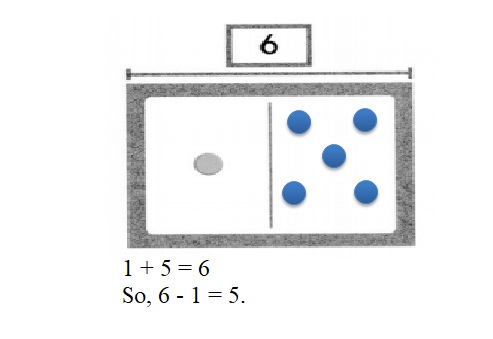
Question 8.
Choose two addition equations that match the picture.
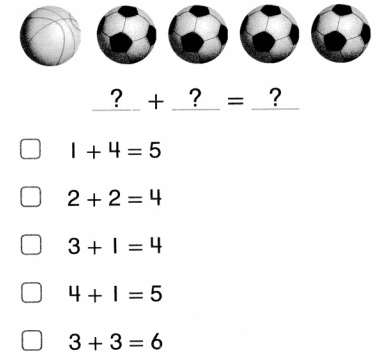
Answer:

Question 9.
Choose two addition equations that can help find 9 – 3.

Answer:

Question 10
Find 5 + 4.
5 + 4 = ___
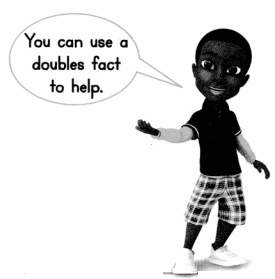
Answer:
5 + 4 = 9
Using the double fact
taking the smallest addend of the two and doubling it
4 + 4 = 8
5 + 4 = 9 = 4 + 4 and 1 more.
Question 11.
Paul has 5 grapes. His friend gives him 3 more. How many grapes does Paul have now?

Answer:

Question 12.
3 frogs sit on a rock. 3 more join them. How many frogs are there in all? Draw a picture and write an equation.

Answer:

Question 13.
Which is a doubles fact?
A. 4 + 2 = 6
B. 4 + 3 = 7
C. 4 + 4 = 8
D. 4 + 5 = 9
Answer:
Double Facts are additions in which a number is added to itself.
In the above equations only C. 4 + 4 = 8 is the double fact.
C. 4 + 4 = 8 id double fact.
Question 14.
Erin is thinking of a number. Her number is 5 less than 10. What doubles fact could you use to find Erin’s number?
10 – 5 = ?
__ + __ = ___
Answer:
The number Erin is thinking = 5 less than 10
Number 5 less than 10 = 10 – 5 = 5
The double fact used to Find Erin’s number = 5 + 5 = 10.
10 – 5 = 5
5 + 5 = 10.
Question 15.
Think addition to help you subtract. Find the missing part. Then write the numbers.

Answer:

Question 16.
Tina wants to buy 6 beads. She can buy red or blue beads. Complete the table to show all the ways Tina can buy the beads.

Answer:

Favorite Fruits
The first-grade students at Park School took a vote on favorite fruits. They made this chart.

Question 1.
How many fewer students voted for Strawberry than Apple? Draw a picture and write an equation to solve.
Answer:
Number of students voted for Apple = 5
Number of students voted for Strawberry = 2
Number of fewer students voted for Strawberry than Apple = 5 – 2 = 3.
3 fewer students voted for Strawberry than Apple.
Question 2.
Laura says that she can use near doubles to find the total number of votes for Banana and Strawberry.
Do you agree?
Circle Yes or No.
Show your work to explain.
Answer:
Number of Banana = 6
Number of Strawberry = 2
Total number of Banana and Strawberry = 6 + 2 = 8
No, i don’t agree to use near doubles because
6 + 2 = 8
To use the near double we use the smaller addend
2 + 2 = 4
6 + 2 = 8 is 2 + 2 and 4 more
4 more is too long.
Question 3.
2 girls voted for Orange. Some boys voted for Orange. How many boys voted for Orange?
Draw a picture to solve. Then write an addition or a subtraction equation.
Write how many boys voted for Orange.
Answer:
Number of students voted for Orange = 4
Number of girl students voted for Orange = 2
Number of boys students voted for Orange = 4 – 2 = 2.
2 boys voted for Orange.

Question 4.
Fewer girls voted for Banana than boys. Complete the chart. Show the different ways boys and girls could have voted.

Answer:

Question 5.
Gina says that Orange and Blueberry have the same total number of votes as Cherry and Peach. Is she correct? Explain how you know.
Answer:
Number of votes for Orange = 4
Number of votes for Blueberry = 3
Number of votes for Cherry = 3
Number of votes for Peach = 4
Number of votes for Orange and Blueberry = 4 + 3 = 7
Number of votes for Cherry and Peach = 3 + 4 = 7.
Yes, Gina is correct.
Both equation
4 + 3 = 7
3 + 4 = 7
Sum in same both the equations.
The addends have same value. 3 and 4
The addends representation in both equations is vice versa.